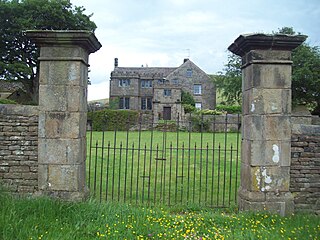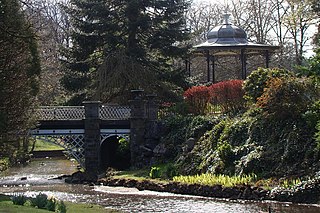
Highlow Hall is a historic Elizabethan manor house in Highlow civil parish, near Hathersage, Derbyshire, England. It was owned by the Eyre family from approximately 1340 to 1842, at which
Somersall Hall is a small country house near Brampton, Chesterfield, Derbyshire. It is a Grade II listed building.

The Bridge Inn is a Grade II listed public house at Bridge Hill, Topsham in the county of Devon, England. Mentioned as a dwelling in the 1086 Domesday Book, the building was largely constructed in the 18th century of cob and stone, with a 19th-century brick addition. Queen Elizabeth II visited the inn on 27 March 1998, her first official visit to a pub.

The Five Mile House is a former pub on Old Gloucester Road, Duntisbourne Abbots, Gloucestershire, England. It was built in the 17th century and is grade II listed.

The Ship and Shovell is a Victorian pub in Craven Passage, Charing Cross, London. It may be unique for consisting of two separate buildings on either side of a street, connected underground by a shared cellar.

The Cockpit is a public house at 7 St Andrew's Hill, in the City, London, where it meets Ireland Yard.

Buxton Pavilion Gardens is a Victorian landscaped public park in the spa town of Buxton in Derbyshire. The River Wye flows through the gardens, which are a Grade II* listed public park of Special Historic Interest.

The Square is a Grade-II*-listed building in Buxton, Derbyshire, England. It lies in the town's central Conservation Area immediately between The Crescent, the Old Hall Hotel, the Pavilion Gardens and the Buxton Opera House.

The Slopes is a Grade-II-listed public park in Buxton, Derbyshire in England. The area was laid out by landscape architect Jeffry Wyatville in 1811 for William Cavendish, 6th Duke of Devonshire, as pleasure grounds for the guests of The Crescent hotel to promenade. The design of The Terrace was modified further by Sir Joseph Paxton in 1859.
The pubs and inns in Buxton are an important part of the historical character of the town of Buxton, Derbyshire, in England. The inns date back to the 16th century and several are listed buildings. Most are within the Conservation Areas of Higher Buxton, Central Buxton and Fairfield.

Buxton Town Hall was opened in 1889 on the Market Place in Buxton, Derbyshire, England. It lies in the town's central Conservation Area overlooking The Slopes. It is a Grade-II-listed building.

The Palace Hotel was opened in 1868 in Buxton, Derbyshire, England. It holds a prominent position in the town's central Conservation Area overlooking the town. It is a Grade-II listed building.
Castleton is a civil parish in the High Peak district of Derbyshire, England. The parish contains 25 listed buildings that are recorded in the National Heritage List for England. Of these, one is listed at Grade I, the highest of the three grades, one is at Grade II*, the middle grade, and the others are at Grade II, the lowest grade. The parish contains the village of Castleton and the surrounding countryside and moorland. The most important building in the parish is the ruined Peveril Castle, which is listed at Grade I. The other listed buildings include houses, cottages and associated structures, farmhouses and farm buildings, a church and a sundial in the churchyard, a hotel and a public house, a former watermill, three mileposts, a school, a war memorial, and a telephone kiosk.

Castleton Hall is an 18th-century grade II listed country hall on Castle Street in Castleton, Derbyshire.

Losehill Hall is a 19th-century grade II listed country hall on Squires Lane on the outskirts of Castleton, Derbyshire.

Goosehill Hall is an 18th-century Grade II listed country hall on Squires Lane on the outskirts of Castleton, Derbyshire.

Wormhill Hall is a 17th-century grade II* listed country hall in Wormhill, Derbyshire.

The Castleton town defences in Castleton, Derbyshire, consist of a ditch and bank constructed during the 1190s. The ditch was part of Peveril Castle's medieval defence system.

Castleton War Memorial is a 20th-century grade II listed war memorial in Castleton, Derbyshire.

Mompesson's Well is a 17th-century grade II listed water well in Eyam, Derbyshire.


















